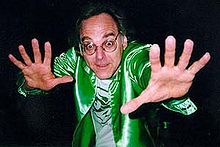- Mike Jittlov
-
Mike Jittlov 
Mike Jittlov in 1996Born June 8, 1948
Los Angeles, CaliforniaOccupation special effects animation Website http://www.wizworld.com/ Mike Jittlov (born June 8, 1948) is an American animator and the creator of short films and one feature length movie using forms of special effects animation, including stop-motion animation, rotoscoping, and pixilation. He is best known for the 1987 feature-length film The Wizard of Speed and Time, based on his 1979 short film of the same name.[1]
Life
Born in Los Angeles, Jittlov became a math-language major at UCLA. Jittlov took an animation course to satisfy his art requirement. He made a super-8 film, The Leap, enlarged to 16mm to participate in film festivals in the early 70s. Jittlov entered a 16mm film made for his UCLA class, Good Grief, into Academy Awards competition. That short made it to the professional finals for nomination, the first of several of his short films to do so. Afterwards, Jittlov bought his own 16mm movie camera, designed his own multiplane animation system for $200, and began his career.
Some of his other original film shorts, including The Interview, Swing Shift, Animato, and Time Tripper (released separately and as a collection called Animato) won many top awards and repeat film festival screenings, bringing him to the attention of The Walt Disney Studio. In 1978, Jittlov co-starred on Disney's two-hour TV extravaganza, Mickey's 50th, with the short film Mouse Mania, creating and animating the first stop-motion Mickey Mouse, along with 1,000 other Disney toys marching around a psychiatrist's office. The short is now featured on the Disney DVD Mickey Mouse in Living Color, Volume Two. Since Disney did not allow usually individual creators to receive credit on their television productions (preferring a generic thanks to "the many Disney animators who made this possible") Mike put his and partner Deven Cheregino's name on the toys in the final production number, where they couldn't be edited out. In late 1979, he co-starred again on Disney's Major Effects television special - this time introducing the world to the 500 mph Green "Wizard of Speed and Time" via the short film version. With an improved soundtrack, the short was released to 16mm film collectors in 1980, along with four of his other short films.
Jittlov also created the inaugural short film played on the cable TV Disney Channel. It featured an animated satellite shaped like Mickey Mouse's head, which was later reproduced for the special features of the DVD version of Disney's 1937 film, Snow White and the Seven Dwarfs. The Mickey Satellite film played to park-goers waiting in line at Space Mountain for years, and is still shown to Walt Disney Parks and Resorts employees during orientation. The prop was also used in a scene in The Wizard of Speed and Time.
Jittlov is best known for his feature movie The Wizard of Speed and Time, which he directed and starred in. The movie did poorly in theatres but has established a cult following since its release on videotape and laserdisk.
He later worked as a special effects technician on the movie Ghost and in fan films including Darth Vader's Psychic Hotline.
Jittlov distinguishes himself in terms of appearance at science fiction conventions by wearing his traditional green jacket and green shoes like the ones seen in The Wizard of Speed and Time. He was an early Internet user, with his own website, and frequent poster to his own Usenet group, alt.fan.mike-jittlov. He is also a prolific practitioner of origami.
References
External links
Categories:- Special effects people
- Stop motion animators
- 1948 births
- Living people
Wikimedia Foundation. 2010.
